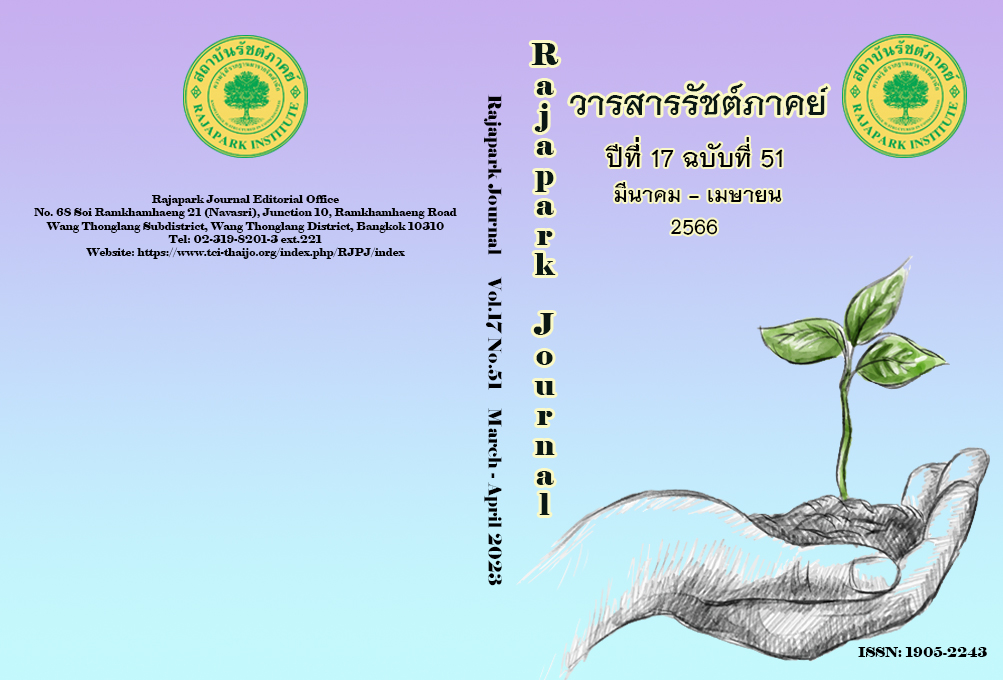Influence of Touch Points on the Loyalty of Customers of Cha Tra Mue
Main Article Content
Abstract
This research was quantitative. The purposes of this research were: (1) to study the level of touch points and the loyalty of customers of Cha Tra Mue; (2) to compare the loyalty of customers of Cha Tra Mue, classified by personal factors; and (3) to study touch points that affect the loyalty of customers of Cha Tra Mue. The population consisted of ready-to-drink customers of Cha Tra Mue; samples were taken from 400 informants. The research instrument was a questionnaire. The reliability was 0.964. The statistics used to analyze the data were percentage, mean, standard deviation, independent sample T-test, one-way ANOVA, and stepwise multiple regression analysis. The results of the research were as follows: (1) the level of touch points and the loyalty of customers of Cha Tra Mue were at a high level overall; (2) the comparison of the loyalty of customers of Cha Tra Mue classified by personal factors was not statistically significant different; (3) touch points during purchase (X2) and touch points after purchase (X3) that affect the loyalty of customers of Cha Tra Mue. The effective prediction accounted for 47.90 percent. The equation of the model was Y = 1.016 + 0.544(X2) + 0.187(X3).
Article Details

This work is licensed under a Creative Commons Attribution-NonCommercial-NoDerivatives 4.0 International License.
Views and opinions appearing in the Journal it is the responsibility of the author of the article, and does not constitute the view and responsibility of the editorial team.
References
Bolton, R. N., Gustafsson, A., McColl-Kennedy, J., Sirianni, N. J., & Tse, D. K. (2014). Small Details that Make Big Differences: A Radical Approach to Consumption Experience as a Firm’s Differentiating Strategy. Journal of Service Management, 25(2), 253-274.
Cherdboonmuang, S., & Sawang, S. (2018). The Development of Perception-Based Model for Customer Loyalty in Modern Convenience Store Brand in Bangkok. Journal of Business Administation: The Association of Private Higher Education Institutions of Thailand,
(Special), 57-72.
Duncan, T. (2005). Principles of advertising & IMC (2nd ed.). McGraw-Hill.
Hayes, B. (2014, April 1). Customer Loyalty is Alive and Well. Business Over Broadway: B.O.B. http://businessoverbroadway.com/2014/04/01/customer-loyalty-is-alive-and-well/
Issara, D. (2017). Experiential Journey of Modern and Traditional Retail Service in Small Town: A Case Study of Eastern Lanna Customer[Doctoral Dissertation, Naresuan University].
Jarusan, P. (2017). Connect to Library Service with CEM: A Case Study of Sukhothai Thammathirat Open University Library. PULINET Journal, 4(1), 89–95.
Kittinorarat, J., & Paholpak, J. (2019). Service Quality and Building Customer Loyalty: The Contextual Components of Mobile Phone Service Operators in Thailand. Journal of Economics and Management Strategy, 6(1), 135–151
Khani, A. H., Khajeh, H. B., & Aali, S. (2014). Studying the relationship between customer relationship management and relationship marketing at Iran Melli Bank of Metropolitan Tabriz: Spring 2013. Indian Journal Science, 3(1), 400–407.
Khunrat, P. (2020). Story of Ready to Drink Tea Business in Thai Society from the 1990s until the 2010s[Master’s Thesis, Srinakharinwirot University].
Myongjee, Y., & Billy, B. (2013). Customer loyalty marketing research: A comparative approach between hospitality and business journals. International Journal of Hospitality Management, 33, 166–177.
Opasbutr, T., & Pornwasurat, P. (2020). Customer Experience Management on the “New Normal”. Siam Communication Review, 19(2), 169–180.
Pankeaw, P. (2016). Service Marketing Mix Factors Affecting Customer Loyalty of Using Services of Government Savings Bank in Kanchanaburi Office[Independent Study, Kanchanaburi Rajabhat University].
Phakakarvathin, S., & Sucher, W. (2019). Application of Marketing Innovation: Success of Traditional Thai Tea (Cha Tra Mue). In Proceeding The 3rd National Academic Conference (pp. 274–284). Graduate School of Tourism Management, NIDA.
Phensuk, T. (2018). Factors Affecting Consumer Decisions about Cha Tra Mue Brand Thai Tea Mix[Independent Study, Thammasat University].
Phongjirakhorn, C., Nonthanathorn, P., Laohavichien, T., & Srivardhana, T. (2020). The Relationship of Social Media Influencer, Customer Experience Management, Customer Engagement and Service Brand Evaluation to Brand Trust in Beauty Clinic Business.
Srinakharinwirot Business Journal, 11(2), 89–111.
Puttes, R., & Wetprasit, W. (2021). The Structural Relationship of Marketing Strategies, Service Quality and Corporate Image Perception that Affects the Customer Loyalty of the Electronic Commerce Group of Thai Post Company Limited, Phetchaburi Province. Academic Journal of Phetchaburi Rajabhat University, 11(1), 175-186.
Rangyai, T. (2017). Loyalty Model of Hotel Business customer in Bangkok Metropolis and Perimeters. Academic Journal Phranakhon Rajabhat University, 8(1), 41–51. https://so01.tci-thaijo.org/index.php/AJPU/article/view/63817
Rungkrajang, T., & Supornpraditchai, T. (2016). Customer Experience of Thai Stamp Members Related to Brand Loyalty of Thailand Post Company Limited. Panyapiwat Journal, 8(1), 67-78.
Sakdaar, P., & Chaiwongkeat, C. (2020). Measuring Customer Loyalty for Airline Business. Journal of Management Sciences, Surat Thani Rajabhat University, 7(1), 1-24. https://so03.tci-thaijo.org/index.php/msj/article/view/243750
Silanoi, L. (2017). How to Use the Appropriate Statistical Formulas for Determining the Sample Size for Quantitative Research Designs in The Humanities and Social Science Study. Journal of Research and Development Burirum Rajaphat University, 12(2), 50–61.
Sriviroj, S. (2019). Can Customer Experience Management Actually Create Satisfaction and Loyalty to Business?. EAU Heritage Journal, Social Science and Humanity, 9(2), 35-43.
Suwannawong, W. (2018). The Influence of Triple C Strategy on the Decision to Use Starbucks in Bangkok[Independent Study, Bangkok University].
Tanvittayanont, P., Sukpach, K., & Suveatwatanakul, C. (2019). Customer Experience Management, Value, and Satisfaction of Customer in Outbound Tourism Business: Theoretical Frame Work. Dusit Thani College Journal, 13(1), 107–122.
The Department of Trade Negotiations. (2020, May). Thai Tea Market and Tea Products. The Department of Trade Negotiations. https://api.dtn.go.th/files/v3/5f48d4a1ef414051e32f1a8e/download
Yomchinda, L., & Yomchinda, T. (2017). Brand Touchpoint: Customer Experience Improving. Graduate School Journal, Chandrakasem Rajabhat University, 12(2), 1–11. https://so01.tci-thaijo.org/index.php/journalgrdcru/article/view/130216
Zeithaml, V. A., Berry, L. L., & Parasuraman, A. (1996). The behavioral consequences of service quality. Journal of Marketing, 60, 31–46.


